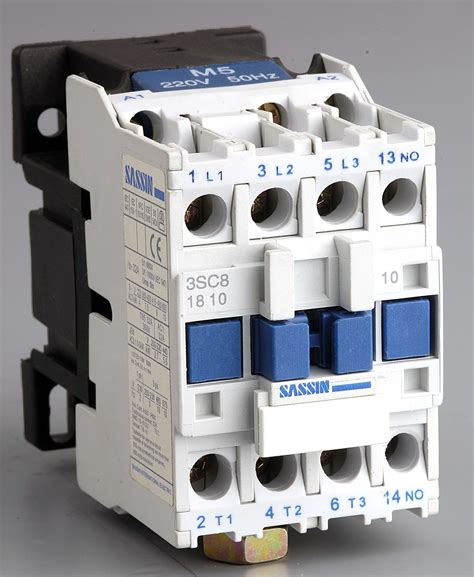Contactors: The Unsung Heroes of Electrical Control
Contactors, often overlooked but indispensable in the realm of electrical control, play a crucial role in automated systems across industries. These electromechanical switches serve as the bridge between low-power control circuits and high-power electrical loads, allowing for efficient and safe operation.
What is a Contactor?
A contactor is an electrically operated switch designed to handle heavy-duty currents. It consists of a coil that, when energized, creates a magnetic field that attracts an armature, closing the contacts and completing the circuit. When the coil is de-energized, the contacts open, interrupting the flow of current.
Contactors differ from relays in that they are designed for higher current applications and can withstand extended periods of operation without overheating.

Types of Contactors
Contactors come in various types, each suited to specific applications:
-
AC Contactors: Designed for alternating current (AC) circuits, commonly used in industrial and commercial settings.
-
DC Contactors: Used in direct current (DC) circuits, often found in automotive and battery-powered systems.
-
Vacuum Contactors: Utilize a vacuum to extinguish the arc created when the contacts open, providing longer lifespan and higher reliability.
-
Solid State Contactors: Use solid-state electronics to control the flow of current, offering superior reliability and faster switching speeds.
Applications of Contactors
Contactors find widespread use in a multitude of applications, including:

- Motor Control: Starting and stopping electric motors
- Lighting Control: Switching on and off lighting systems
- Heating and Cooling Control: Managing temperature in HVAC systems
- Energy Management: Optimizing energy consumption in industrial and commercial buildings
- Automation: Automating processes in manufacturing, agriculture, and other industries
Why Contactors Matter
Contactors play a critical role in electrical control systems for several reasons:

-
Safety: Contactors isolate high-voltage loads from the low-voltage control circuits, preventing electrical hazards and protecting equipment.
-
Reliability: Contactors provide a robust and reliable method of switching high currents, reducing the risk of system failures.
-
Efficiency: Contactors optimize energy consumption by allowing for efficient switching of loads, reducing energy waste.
-
Compactness: Contactors are relatively compact devices, making them ideal for space-constrained applications.
-
Versatility: Contactors are available in a wide range of sizes and configurations, making them suitable for various applications.
Benefits of Using Contactors
Implementing contactors in electrical control systems offers numerous benefits:
-
Improved Safety: Enhanced worker and equipment protection by isolating high-power loads.
-
Reduced Downtime: Reliable contactor operation minimizes system downtime, increasing productivity.
-
Energy Savings: Efficient switching reduces energy consumption, leading to cost savings.
-
Extended Equipment Life: Contactors protect motors and other equipment from damage caused by excessive current or overheating.
-
Simplified Maintenance: Contactors are designed for easy maintenance and replacement, reducing maintenance time and costs.
Effective Strategies for Using Contactors
To maximize the effectiveness of contactors, consider the following strategies:
-
Proper Sizing: Select contactors with the appropriate current and voltage ratings for the application.
-
Matching Coil Voltage: Ensure the contactor coil matches the supply voltage to avoid overheating or under-performance.
-
Use of Overload Relays: Add overload relays to protect contactors from overcurrent conditions.
-
Arc Suppression: Install surge suppressors to protect contactors from voltage transients.
-
Preventive Maintenance: Regularly inspect and replace worn or damaged contacts to ensure reliable operation.
Common Mistakes to Avoid with Contactors
Common pitfalls to avoid when using contactors include:
-
Overloading: Do not exceed the current rating of the contactor, as this can lead to overheating and damage.
-
Undersized Coil: Using a contactor with a coil rated for a lower voltage can result in poor performance and premature failure.
-
Improper Connections: Incorrect wiring can cause malfunctions and safety hazards.
-
Ignoring Overload Protection: Failing to install overload relays can compromise safety and equipment protection.
-
Neglecting Maintenance: Lack of regular maintenance can lead to contact wear, reduced performance, and increased risk of failure.
Tables
Table 1: Contactors by Application
| Application |
Contactor Type |
| Motor Control |
AC or DC Contactor |
| Lighting Control |
AC Contactor |
| Heating and Cooling Control |
AC or DC Contactor |
| Energy Management |
Solid State Contactor |
| Automation |
AC or DC Contactor |
Table 2: Advantages and Disadvantages of Different Contactor Types
| Contactor Type |
Advantages |
Disadvantages |
| AC Contactor |
Widely available, cost-effective |
Generates arcing, limited switching frequency |
| DC Contactor |
No arcing, high switching frequency |
Higher cost, more complex design |
| Vacuum Contactor |
Long lifespan, reliable |
Bulky, requires vacuum maintenance |
| Solid State Contactor |
Fast switching, no arcing |
Sensitive to overloads, higher cost |
Table 3: Common Causes of Contactor Failure
| Cause |
Percentage |
| Contact Wear |
52% |
| Coil Failure |
18% |
| Overload |
15% |
| Mechanical Failure |
9% |
| Arcing |
6% |
Call to Action
Contactors are indispensable components in electrical control systems, ensuring safety, reliability, and efficient operation. By understanding their types, applications, benefits, and best practices, you can harness their power to optimize your electrical systems and drive productivity. Implement effective strategies and avoid common pitfalls to maximize the value of contactors in your applications.
